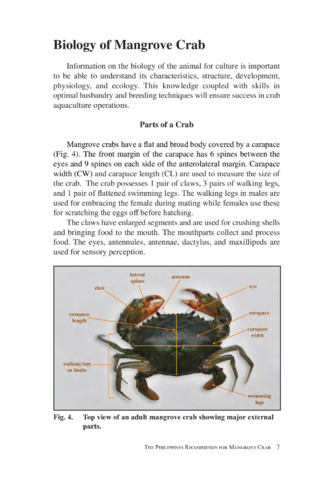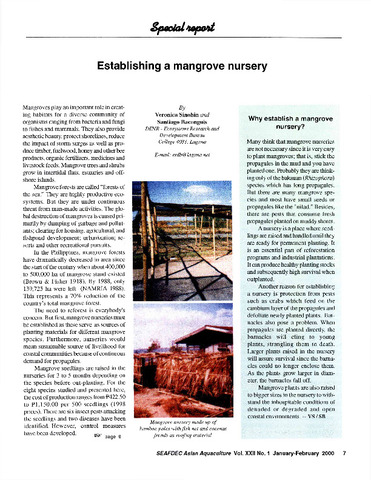Field guide to mangrove identification and community structure analysis
- Global styles
- MLA
- Vancouver
- Elsevier - Harvard
- APA
- Help
Share
Abstract
The mangrove field guide is a 32-page field guide with a one page introduction on mangroves, followed by a key to mangrove genera and species (with colored pictures of the whole plant and plant parts), then a definition of important terms used in the key, species code for use during mangrove community structure, instructions on how to conduct mangrove community structure analysis plus the formulas for the different indices (relative density, dominance, frequency; importance value and species diversity) and a sample data sheet. The guide, measuring 9 cm x 14 cm, is printed on PVC material hence it can get wet, soaked or be left in the water for days.
Suggested Citation
Lebata-Ramos, M. J. H. (2013). Field guide to mangrove identification and community structure analysis. Tigbauan, Iloilo, Philippines: Aquaculture Department, Southeast Asian Fisheries Development Center.
Type
BookISBN
9789719931027Format
32 pages : color illustrations ; case 16 x 12 x 2 cm.
Collections
Related items
Showing items related by title, author, creator and subject.
-
Handbook of mangroves in the Philippines - Panay
Primavera, Jurgenne ; Sadaba, Resurreccion
; Sadaba, Resurreccion  ; Lebata, Ma. Junemie Hazel L.
; Lebata, Ma. Junemie Hazel L.  ; Altamirano, Jon
; Altamirano, Jon  (Aquaculture Department, Southeast Asian Fisheries Development Center, 2004)
A 106-page guide is a user-friendly presentation of technical botanical description and illustrations of Philippine mangrove species in Panay Island, Guimaras and Aurora Province. Vegetative and reproductive structures of ...
(Aquaculture Department, Southeast Asian Fisheries Development Center, 2004)
A 106-page guide is a user-friendly presentation of technical botanical description and illustrations of Philippine mangrove species in Panay Island, Guimaras and Aurora Province. Vegetative and reproductive structures of ... -
[The Philippines recommends for mangrove crab:] Biology of mangrove crab
The Mangrove Crab Technical Committee 2018 (DOST-PCAARRD, 2021) -
Establishing a mangrove nursery
Sinohin, Veronica; Baconguis, Santiago (Aquaculture Department, Southeast Asian Fisheries Development Center, 2000)Mangroves play an important role in creating habitats for a diverse community of organisms ranging from bacteria and fungi to fishes and mammals. They grow in intertidal flats, estuaries and offshore islands. In the ...




